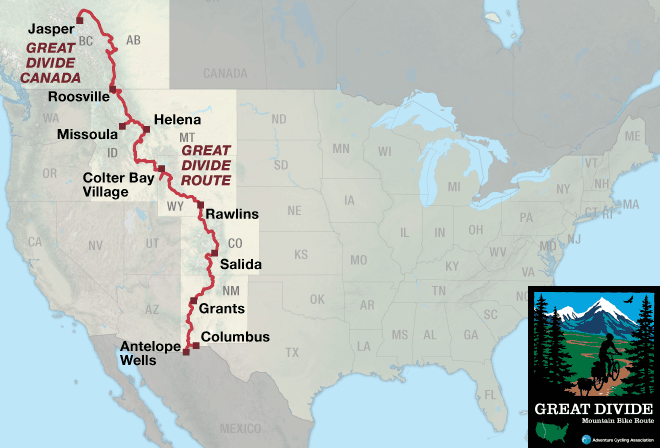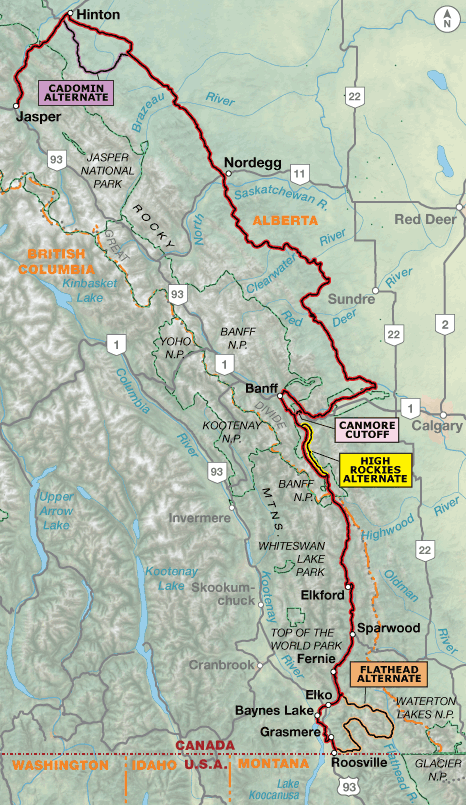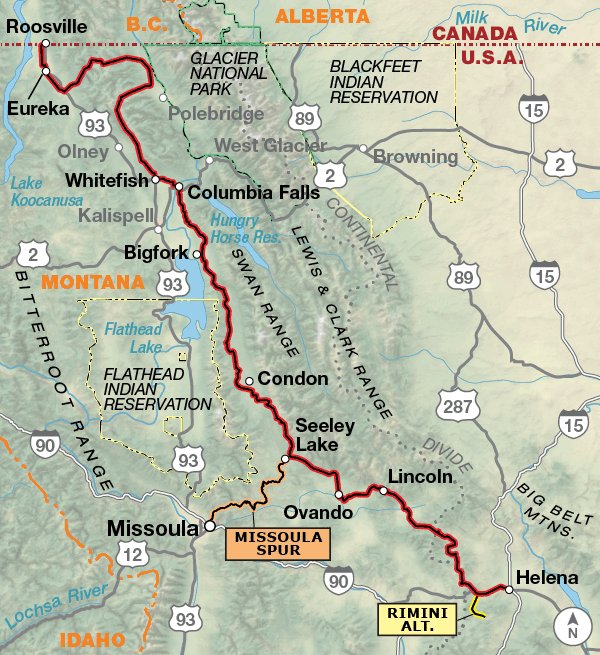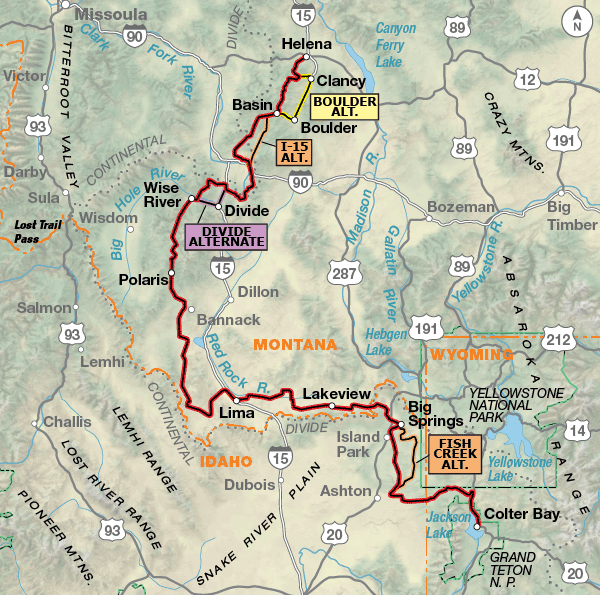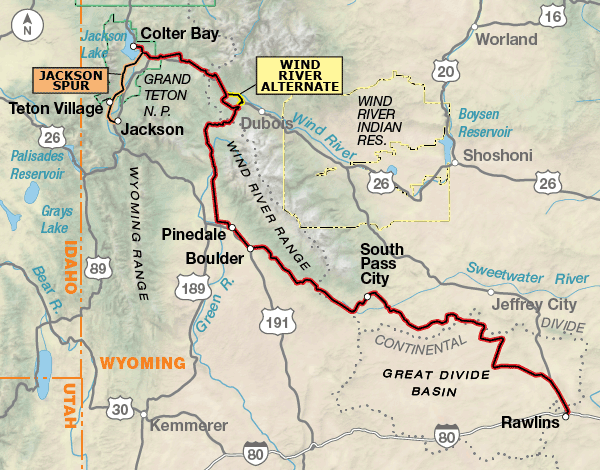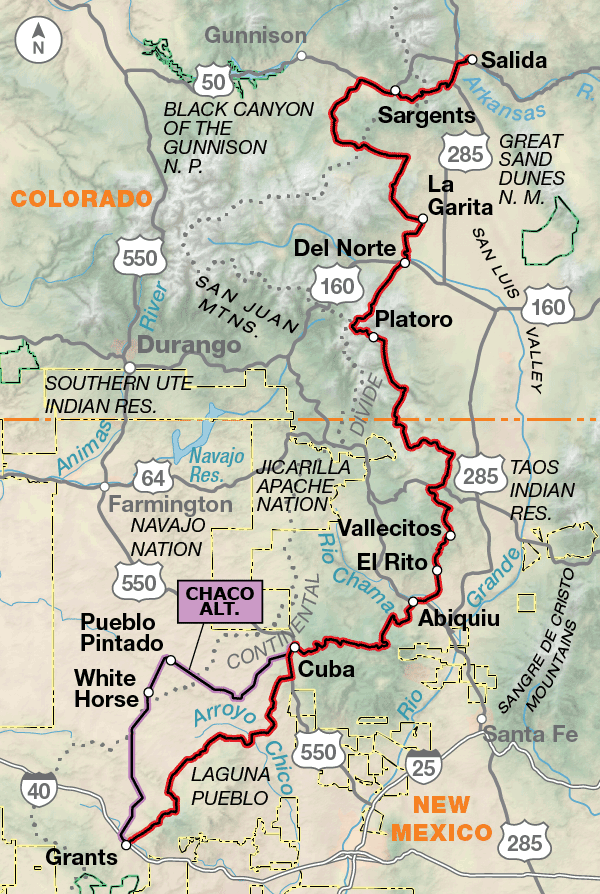Great Divide Mountain Bike Route
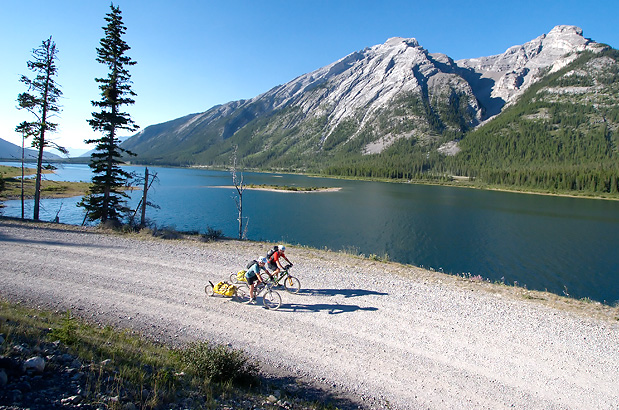
| Great Divide Mountain Bike Route Jasper, AB to Antelope Wells, NM 7 Map Set | GPX Data | Overview | Buy | Mobile App |
|---|---|
| CANADA. Jasper, AB to Roosville, MT | Detail |
| 1. Roosville, MT to Helena, MT | Detail |
| 2. Helena, MT to Colter Bay, WY | Detail |
| 3. Colter Bay, WY to Rawlins, WY | Detail |
| 4. Rawlins, WY to Salida, CO | Detail |
| 5. Salida, CO to Grants, NM | Detail |
| 6. Grants, NM to Antelope Wells, NM | Detail |
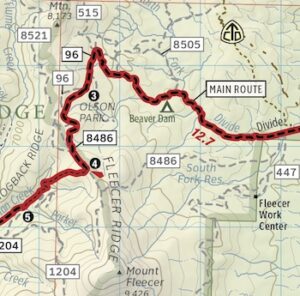 In 2018, for the 20th anniversary of the Great Divide Mountain Bike Route, we completely redesigned the maps. They now feature shaded relief, consolidated narratives that may be cut off and carried separate from the maps, a UTM and lat/long grid, point to point mileages and the often requested south to north narratives. We also upped the scale to show greater detail aiding your navigation, especially helpful on many of the lesser known roads and trails this route showcases.
In 2018, for the 20th anniversary of the Great Divide Mountain Bike Route, we completely redesigned the maps. They now feature shaded relief, consolidated narratives that may be cut off and carried separate from the maps, a UTM and lat/long grid, point to point mileages and the often requested south to north narratives. We also upped the scale to show greater detail aiding your navigation, especially helpful on many of the lesser known roads and trails this route showcases.
Ride the longest off-pavement route in the world.
The Great Divide Mountain Bike Route (GDMBR) is Adventure Cycling’s premier off-pavement cycling route, crisscrossing the Continental Divide in southern Canada and the U.S. This route is defined by the word “remote.” Its remoteness equates with spectacular terrain and scenery. The entire route is basically dirt-road and mountain-pass riding every day. In total, it has over 200,000 feet of elevation gain. Nearly 2,100 miles of the route is composed of county, Forest Service, Bureau of Land Management (BLM), and Canadian provincial unpaved roads. The remainder is 60 miles of singletrack trails and 950 miles of paved roads including close to 50 miles of paved bike paths.
Highlights from the Great Divide Mountain Bike Route
The route is geographically divided into five regions. The diverse nature of the regions makes for an incredible visual, sometimes spiritual experience. The route offers something different every day — whether it be riding conditions, scenery, points of interest, or folks along the way. It is a route to be enjoyed for its diversity.
A wide variety of road conditions exists along this route. Surfaces range from pavement, good gravel roads, four-wheel-drive roads, singletrack, or old railroad beds. There is an excellent opportunity to view wildlife such as bear, deer, wild horses, pronghorn antelope, eagles, osprey, sandhill cranes, and other birds and animals. The route is rich in history, with ghost towns, deserted mines, wagon routes, and old Spanish land grants. The route is near or goes through several national parks such as Glacier, Yellowstone, and Grand Teton. Temperatures tend to be chilly at night and cool to warm in the days as you are in mountainous regions most of the way. Wind really isn’t a factor along the route because you spend a lot of time in the cover of trees, with the exception of the Great Basin area. Snow, hail, and afternoon thundershowers can be a factor. Getting up and riding early to avoid the afternoon thundershowers is advisable. Medical help is often a long distance off of the route, so riding within your abilities and being aware of dangers is a must. Mosquitoes are a fact of life — take repellent.
Great Divide Canada, which connects to and extends the U.S. Great Divide Mountain Bike Route northward, showcases some of the most magnificent scenery in the entire Rocky Mountain chain. Paradoxically, the route feels somewhat more settled, or civilized, than many sections to the south in the United States. One reason for this is that Great Divide Canada passes through a string of national and provincial parks, which, not surprisingly, attract a great number of visitors.
Beginning in Jasper, the route counterintuitively runs north to Hinton before heading southward toward Canmore. The paved Legacy Trail brings riders into Banff and through spectacular scenery to Peter Lougheed Provincial Park. From there, a tough climb up and over the Great Divide via a powerline route through the Elk Pass delivers you to Elk Lakes Provincial Park. It’s a six-mile ride from one trailhead to the other that would require more than 200 miles of driving if you had to do it in a car on roads!
The main route rolls onto the Elk Valley Trail beginning in the tiny community of Round Prairie and follows portions of it on-and-off to the town of Elko. The 80-mile EVT consists of back country roads, singletrack and community trails. Before you reach its end, the booming ski-resort town of Fernie makes a great place for a layover, with its copious motels, sporting goods stores, restaurants, and hiking/mountain-biking trails.
South of Fernie, you can continue on the main route or choose to ride through miles of unbridled wilderness on the Flathead Alternate. Make your choice wisely because the alternate route is extremely remote. It runs through a scenic drainage called the “Serengeti of North America” by biologists for its unrivaled wildlife populations, and it’s the last major valley in British Columbia to be completely undeveloped. The rolling road following the Flathead River is known to locals as “Grizzly Bear Highway” so be very “bear aware.” Along the main route, a dizzying and delightful series of paved and gravel byways, one of which proffers a brief glimpse down on the immense Lake Koocanusa, then wend their way to Grasmere. From there, it’s a seven-mile ride on the highway to the international border and the northern terminus the U.S. route.
Beginning at the Canadian border and heading south to Helena, Montana, you are in the deep woods and steep mountains near Glacier National Park and the Bob Marshall Wilderness. This area is native to grizzly bear, elk, moose, mountain lion, thick woods, and has some difficult climbing. Montana is characterized by mountainous riding in tall forests with occasional dips into small towns. It is also noted for its friendly people. The capital city in Montana, Helena, has less than 40,000 people and a nice small-town feel to it. The other big town along the route is Butte, which has a definite blue-collar, mining flavor. Montana also has the toughest downhill on the route — nicknamed “thermarest hill” for all the thermarests it has eaten. Even the hardiest riders have to walk this one.
From Butte to Pinedale, Wyoming, you’ll be riding through wide-open mountain valleys. The vegetation thins out into valleys with many different varieties of sage and high-elevation alpine woods. The route crosses the Continental Divide many times, and the climbing is longer with very steep sections on some of the roads. You’ll see many cows. You leave Montana crossing the divide into Idaho. You are only in Idaho for 76 miles and ride along some blue-ribbon fishing streams and an old railroad bed on the west side of Yellowstone National Park. You’ll cross into Wyoming between Yellowstone and Grand Teton National parks on a very scenic road with some great backcountry campsites and a genuine undeveloped hot springs. The route cuts through a corner of the Tetons before heading east up over the divide again and then down the west side of the Wind River Range. The prettiest alpine region on the whole route can be found here. Just south of Pinedale, is a stretch with the worst mosquitos on the entire route but makes for a great character builder. Farther on there’s the unforgettable sensation of riding on the crest of the divide for several miles. You then hit an extremely picturesque section of high desert following the Lander cutoff — part of one of the westward wagon routes. Water is very scarce through here, so carry plenty. After dropping into the twin ghost towns of South Pass and Atlantic City, you will cross the Great Basin — a place of almost no drinkable water and no trees. Big northwest winds blow across vast open territory marked with wild horses and antelope. Rawlins, Wyoming, marks the end of the desert.
From southern Wyoming to northern New Mexico, you’ll be in the Colorado Rockies. The ascents on the route stretch out to long mountainous climbs at elevations starting at 8,000 feet or above. Incredible aspen stands, huge mountains, beautiful alpine meadow flora, historical tourist towns, and a less remote wilderness setting are the characteristics of this state. Expect early evening thunderstorms and cold nighttime temperatures. The highest pass of the route is Indiana Pass, elevation 11,910 feet, in southern Colorado. Soon after crossing it, you get to see firsthand what kind of scars mining can leave on the land as you pass right through a federal Superfund site. Heading into New Mexico, the road surface deteriorates, with much more rocky riding. Here the countryside turns much drier, and water sources can be few and far between. Climbs get shorter and steeper. Geographically this region is as remote as any place in the continental United States. Mesas, cliff lines, volcanic formations, and mountain ranges that seem to pop right out of the desert floor are major visual features of this area. Many different cactus and grass varieties somehow provide habitat for small rodents, snakes, and lizards. Townspeople are right out of Old Mexico, with Spanish spoken more than English. Late-summer monsoon rains turn roads into sloppy, red clay and can fill many of the dry creek beds on the route in seconds. Roads are impassable until they dry out. This area is both historically and anthropologically dominated by the rich Native American and southwestern Spanish culture. Coming down the east side of the Gila Wilderness is a welcome relief, with water once again available as you head into Silver City, New Mexico, a place noted for learning about Anasazi culture with the Gila Cliff Dwellings National Monument north of town and a good museum at the local university. From there it is a sprint south (mostly on pavement, unless you decide to take the rugged Big Hatchet digital-only alternate) to the border crossing in Antelope Wells, which consists of one building on the border and nothing else for miles and miles. Alternatively, you can choose to end in the village of Columbus (pop. 1,442) via the paved Columbus Alternate or the rough and remote Tres Hermanas digital-only alternate.
Photo by Aaron Teasdale
The elevations encountered on Great Divide Canada are relatively low when compared to those along the Great Divide route in the central Rockies of the United States, where riders must tackle mountain passes of nearly 12,000 feet above sea level. The high point on Great Divide Canada, Elk Pass, is a mere 6,443 feet. Generally, road quality is quite good, although you’ll find that surfaces range from smooth pavement to rutted dirt, where you’ll be thankful that you’re riding a mountain bike and not a road bike. As a rule, if you’re not riding uphill, then you’re headed downhill.
With the exception of the Great Basin in Wyoming, you will be either gaining elevation, or descending, for the entire route. The elevations are lower in Montana — building up to the highest passes in Colorado and then tapering back off in New Mexico. However, some of the toughest climbs are in Montana and New Mexico because of the steepness and the poor road quality. And in New Mexico you’ll be carrying extra food and water for the serviceless stretches.
| Great Divide Mountain Bike Route - Main Route | ||||
|---|---|---|---|---|
| Section | Distance | Elevation | Total Climb | Avg. Climb/mile |
| Total | 3097.3 miles | Minimum: 2,565 ft.Maximum:11,950 ft. | 207,535 ft. south bound206,075 ft. north bound | 67 ft. per mi. south bound67 ft. per mi. north bound |
| CANADA | 585.1 miles | Minimum: 2,485 ft.Maximum:6,410 ft. | 38,955 ft. south bound39,660 ft. north bound | 67 ft. per mi. south bound68 ft. per mi. north bound |
| 1 | 371.1 miles | Minimum: 2,565 ft.Maximum:6,840 ft. | 28,495 ft. south bound26,975 ft. north bound | 77 ft. per mi. south bound73 ft. per mi. north bound |
| 2 | 453.3 miles | Minimum: 4,030 ft.Maximum:7,915 ft. | 30,150 ft. north bound27,450 ft. south bound | 67 ft. per mi. north bound61 ft. per mi. south bound |
| 3 | 365.5 miles | Minimum: 6,520 ft.Maximum:9,665 ft. | 19,350 ft. south bound19,405 ft. north bound | 53 ft. per mi. south bound53 ft. per mi. north bound |
| 4 | 377.8 miles | Minimum: 6,525 ft.Maximum:11,500 ft. | 29,350 ft. south bound28,900 ft. north bound | 78 ft. per mi. south bound76 ft. per mi. north bound |
| 5 | 539.2 miles | Minimum: 5,880 ft.Maximum:11,950 ft. | 41,740 ft. south bound42,335 ft. north bound | 77 ft. per mi. south bound79 ft. per mi. north bound |
| 6 | 405.3 miles | Minimum: 4,315 ft.Maximum:8,260 ft. | 19,495 ft. south bound21350 ft. north bound | 48 ft. per mi. south bound53 ft. per mi. north bound |
| Great Divide Mountain Bike Route Alternates | ||||
|---|---|---|---|---|
| Name | Section | Distance | Total Climb | Avg. Climb/mile |
| Flathead Alternate | CANADA | 93.0 miles | 9,400 ft. south bound9,780 ft. north bound | 101 ft. per mi. south bound105 ft. per mi. north bound |
| Cadomin Alternate | CANADA | 48.0 miles | 4,045 ft. south bound3,530 ft. north bound | 84 ft. per mi. south bound74 ft. per mi. north bound |
| Canmore Cutoff | CANADA | 6.9 miles | 1,475 ft. south bound320 ft. north bound | 214 ft. per mi. south bound46 ft. per mi. north bound |
| High Rockies Alternate | CANADA | 31.2 miles | 4,050 ft. south bound4,025 ft. north bound | 130 ft. per mi. south bound129 ft. per mi. north bound |
| Missoula Spur | 1 | 65.4 miles | 6,845 ft. south bound7,950 ft. north bound | 105 ft. per mi. north bound122 ft. per mi. north bound |
| Rimini Alternate | 1 | 12 miles | 2,040 ft. north bound345 ft. north bound | 170 ft. per mi. north bound29 ft. per mi. north bound |
| Boulder Alternate | 2 | 33.4 miles | 2,315 ft. south bound1,570 ft. north bound | 69 ft. per mi. south bound47 ft. per mi. north bound |
| Divide Alternate | 2 | 18.3 miles | 680 ft. south bound760 ft. north bound | 37 ft. per mi. south bound42 ft. per mi. north bound |
| Fish Creek Alternate | 2 | 42.7 miles | 2,490 ft. south bound3210 ft. north bound | 58 ft. per mi. south bound75 ft. per mi. north bound |
| Jackson Spur | 3 | 40.8 miles | 960 ft. south bound1536 ft. north bound | 24 ft. per mi. south bound38 ft. per mi. north bound |
| Wind River Alternate | 2 | 13.3 miles | 1,390 ft. south bound740 ft. north bound | 105 ft. per mi. south bound56 ft. per mi. north bound |
| Columbine Alternate | 4 | 35.6 miles | 3,730 ft. south bound2535 ft. north bound | 105 ft. per mi. south bound71 ft. per mi. north bound |
| Chaco Alternate | 5 | 117.4 miles | 4,490 ft. south bound4,870 ft. north bound | 38 ft. per mi. south bound41 ft. per mi. north bound |
| El Malpais Alternate | 6 | 38.4 miles | 1,200 ft. south bound580 ft. north bound | 31 ft. per mi. south bound15 ft. per mi. north bound |
| CDT Alternate | 6 | 11.4 miles | 2000 ft. south bound865 ft. north bound | 175 ft. per mi. south bound76 ft. per mi. north bound |
| Columbus Alternate | 6 | 47.0 miles | 545 ft. east bound1075 ft. west bound | 12 ft. per mi. east bound23 ft. per mi. west bound |
| Tres Hermanas Alternate (digital-only) | 6 | 59.2 miles | 1890 ft. east bound2375 ft. west bound | 32 ft. per mi. east bound40 ft. per mi. west bound |
| Big Hatchet Alternate (digital-only) | 6 | 61.0 miles | 1760 ft. south bound1915 ft. north bound | 29 ft. per mi. south bound31 ft. per mi. north bound |
This route can be ridden anytime from early summer to mid-fall (typically June to October). Be aware that snow can occur at any time along the route. If it is a heavy snow year, high-elevation roads in the north may not be open until late June or early July.
Much of this route is remote, and rescue may be delayed or impossible. A minimum group size of three is recommended. If a rider is debilitated in the backcountry, you will want to have at least one person to stay with the injured/sick rider, and another to go for help. Be aware that cell reception is very spotty along much of the route. Additionally, you may wish to carry a personal satellite communications device. Riders should be prepared to consider self-rescue options.
Because June is typically a wet month in the northern Rockies, and often a cold one at the higher elevations, we recommend that you do not attempt to ride prior to late June or early July. High-country snowpack may prevent certain portions from being passable until then, anyway. Concerning the other end of the cycling season, plan on being off the route by mid-October at the latest. Regardless of when you strike out or how long you intend to be there, pack along raingear and cold-weather clothing. Snow or cold rain is possible any day of the year at some of the elevations encountered, and hypothermia is an ever-present possibility.
Remote Terrain Equals Limited Services
The remoteness of this route translates to long stretches of country without basic services, particularly emergency services. All services are minimal at best, except near larger towns, and cell phone coverage is only about 5 percent of the route. About one third of the overnights are characterized as undeveloped wilderness sites, and most others are Forest Service sites with pit toilets and a water source. Food sources are usually small-town establishments, convenience stores, and campground groceries with limited supplies. Towns are spaced every two to three days along most of the route. They tend to be extremely small and often have limited services. It is necessary to be flexible in what you eat. Showers, flush toilets, drinking water, and laundromats are sometimes widely spaced. It is good to have some back-country camping experience before riding the Great Divide to know how to minimally impact the land. The Great Basin in Wyoming and New Mexico both call for long-mileage days and carrying food and water for several days at a time.
Great Divide Canada features some of the most magnificent and forbidding mountain country you’ll ever see — anywhere. You’ll need to deal with a couple of long stretches without basic services. Careful planning will be required to ensure that you have enough food to get you through (though surface water and primitive campgrounds are plentiful). With the exception of large grocery stores in Jasper, Banff, Sparwood, and Fernie, you’ll find food sources to be small-town establishments, often more akin to convenience stores than to supermarkets; consequently, you may find it necessary to exercise flexibility when it comes to menu planning. Also be aware that showers, flush toilets, potable water, and laundromats can be few and far between. It’s wise to have some back-country camping experience before riding Great Divide Canada, and you’ll also want to know the recommended precautions to take when camping and traveling in bear country.
You should also carry bear repellent, available at sporting goods stores in the larger towns of Canada and Montana, and become familiar with its safe and proper use. Always be bear-aware, and follow these rules when camping:
- Store all food, garbage, and other attractants in a bear-resistant manner, well away from your tent. This can include hanging them in a stuff sack from rope slung over a high, isolated tree branch, or storing them in a bear-proof container provided at some campgrounds.
- Attractants such as food leftovers, fish entrails, and bacon grease should not be buried or burned in campfires. Leftover food and waste should be placed in a sealed bag or container and packed out with garbage. If leftover food or other attractants must be burned, do so in a contained fire stove or in an appropriate container over a campfire, then pack out the ash.
Some campgrounds will charge a cyclist traveling alone less if they have hiker/biker sites, but often they will charge the price of a regular tent site, and that can easily be $10-$20/night. If you’re friendly and ask around, you can often get yourself invited to camp in a yard. In national forests you are allowed to camp anywhere on national forest land as long as you “pack it in, pack it out.” Many city parks are free to camp in.
You may also wish to sign up with Warmshowers, a reciprocal hospitality site for bicycle travelers, for other overnight options.
Tough on Equipment
The Great Divide Mountain Bike Route is extremely hard on equipment. The weight of your gear exponentially multiplies the stress of riding steep, fast, rough downhills. Wheels, tires, and drivetrains (chains, cassettes, bottom brackets, chainrings) take a lot of abuse and might need replacing along the course of the entire route. Suspension equipment on the bicycle helps to mitigate the abusive nature of the terrain. That said, nylon pivots of some full-suspension bikes wear out extremely fast and are not recommended. Suspension seatposts, good handlebar grips, and front-suspension forks help smooth out the many miles of washboarded and chuckholed roads. Weighting a suspension fork with panniers works well, evens the weighting of the bike, and adds little extra stress to the fork. Trailers also work well and lighten the rear triangle of the bike.
Well-made camping gear is essential for the many nights of high-elevation cold, dew, and rain. A well-ventilated, free-standing, three-season tent covered by a rainfly with ample vestibule space and a “footprint” ground tarp is a must. Sleeping bags should be rated to below 20 degrees Fahrenheit, and inflatable mattresses add comfort and warmth. A lot of effort must be taken to keep your possessions dry. Pannier covers, dry bags, and plastic freezer bags all work well to keep the rain and dew off clothing and gear. Good rain gear is also essential.
A high-quality water filter is mandatory; advisably, carry one filter per person in your party. Surface water should be ingested only after running it through a good water filter.
From Salida, Colorado south to the Mexico border, puncturevine or goat’s-head (Tribulus terrestris L.) is an invasive plant species that produces thumbtack-like burs capable of puncturing bicycle tires. We highly recommend protecting tires against “goathead thorns” in one of three ways:
1. Sealant-filled or thorn-resistant tubes;
2. Tubeless tires with at least 3oz of sealant per tire;
3. Tire liners, such as Mr. Tuffy tire liner strips.
As for a tire recommendation, we recommend a 2.25” width with a low-profile tread pattern and thick sidewalls.
Shuttles
If you’re in need of a shuttle to complete your Great Divide trip, download our Great Divide Shuttle Options (pdf) for suggestions.
Route Highlights
Great Divide Shuttle Options
Great Divide Shuttle Options PDF
Great Divide Highlights
- Glacier National Park, Section 1
- Pioneer Mountains Scenic Byway, Section 1
- Red Rock Lakes National Wildlife Refuge, Section 2
- John D. Rockefeller Jr. Memorial Parkway, Section 2
- Yellowstone National Park, Section 2
- Grand Teton National Park, Section 2
- Aspen Alley, Section 3
- Steamboat Springs, Colorado, Section 3
- Summit County, Colorado, Section 4
- Boreas Pass, Colorado, Section 4
- Rio Grande National Forest, Colorado, Section 4
- Tusas Mountains, New Mexico, Section 5
- El Malpais National Monument, El Malpais Alternate, Section 5
- Pie Town, New Mexico, Sections 5 & 6
- Gila Cliff Dwellings National Monument, Section 6
- Chihuahuan Desert, Section 6
- Pancho Villa State Park, Columbus Alternate, Section 6
More Route Resources
- Practical Advice for Riding the Great Divide Mountain Bike Route
- Biking with Bears
- How to Be Bear Aware When Bike Camping
- How to Travel with Your Bike on Amtrak
- International Mountain Bicycling Association (IMBA) Rules of the Trail
- Roosville/Grasmere border crossing
- U.S./Canada Visa requirements
- British Columbia Ministry of Forests, Recreation Sites and Trails (British Columbia)
- Alberta Parks and Recreation (Alberta)
- Kananaski Country Maps (Alberta)
- USDA Forest Service Maps
- Dispersed Camping Guidelines
- National Interagency Fire Center
- Kootenai National Forest (Montana)
- Flathead National Forest (Montana)
- Lolo National Forest (Montana)
- Helena-Lewis & Clark National Forest (Montana)
- Beaverhead-Deerlodge National Forest (Montana)
- The Nature Conservancy (Montana)
- Caribou-Targhee National Forest (Idaho)
- Bridger-Teton National Forest (Wyoming)
- Shoshone National Forest (Wyoming)
- Rawlins Bureau of Land Management (BLM) (Wyoming)
- Medicine Bow-Routt National Forest (Wyoming and Colorado)
- Arapaho and Roosevelt National Forests (Colorado)
- Pike and San Isabel National Forests (Colorado)
- Grand Mesa Uncompaghre and Gunnison National Forests (Colorado)
- Rio Grande National Forest (Colorado)
- Carson National Forest (New Mexico)
- Santa Fe National Forest (New Mexico)
- Cibola National Forest (New Mexico)
- Chaco Culture National Historic Park (New Mexico)
- Gila National Forest (New Mexico)
- New Mexico Bureau of Land Management (BLM)
- Antelope Wells and Columbus, New Mexico border crossings
- Connect and share photos with other riders on Instagram: #acaGDMBR
Updates to Recently Released Maps
If you are planning a bike tour, be sure to get the most recent map updates and corrections for your route by selecting the route, and the appropriate section(s), from the drop-down menu below.
Over time maps become less useful because things change. Every year Adventure Cycling’s Routes and Mapping Department create map updates and corrections for every map in the Adventure Cycling Route Network, which now totals 52,047 miles. With the help of touring cyclists like you, we receive updates on routing, services, camping, and contact information. Until we can reprint the map with the new information, we verify the suggested changes and publish corrections and updates here on our website.
PLEASE NOTE: Covid has been particularly hard on the small businesses along our routes. While we do our best to keep the maps and these online updates current, you may encounter more closed businesses and longer stretches with limited or no services.
Refer to these updates for the most current information we have and submit reports of changes to the Route Feedback Form for the cyclists coming after you.
NOTE: Map updates and corrections only pertain to long term changes and updates. For short term road closures, please see the Adventure Cycling’s Routes Temporary Road Closures discussion in our Forums.
